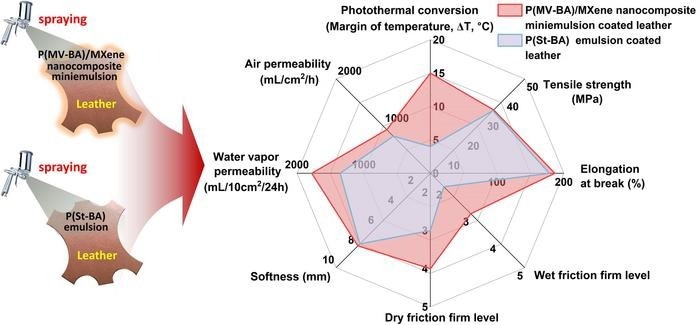Recent research published in the journal Engineering discloses a remarkable advancement in the field of green leather coating materials. Studies have extensively synthesized methacrylated vanillin (MV), a solvent-free, bio-based antibacterial agent and aromatic monomer.
 Comparative analysis of the comprehensive performance of leather coated with P(MV–BA)/MXene nanocomposite miniemulsion and the commercial product P(St–BA), respectively, was evaluated via radar chart array analysis. The key performance evaluation parameters included photothermal performance, mechanical properties, hygienic properties, dry and wet friction firm level, and softness. Figure demonstrates that the tensile strength, elongation at break, and softness of leather coated with P(MV–BA)/MXene nanocomposite miniemulsion were comparable to that of leather coated with the commercial product P(St–BA). Image Credit: Jianzhong Ma, Li Ma, Lei Zhang, Wenbo Zhang, Qianqian Fan, Buxing Han.
Comparative analysis of the comprehensive performance of leather coated with P(MV–BA)/MXene nanocomposite miniemulsion and the commercial product P(St–BA), respectively, was evaluated via radar chart array analysis. The key performance evaluation parameters included photothermal performance, mechanical properties, hygienic properties, dry and wet friction firm level, and softness. Figure demonstrates that the tensile strength, elongation at break, and softness of leather coated with P(MV–BA)/MXene nanocomposite miniemulsion were comparable to that of leather coated with the commercial product P(St–BA). Image Credit: Jianzhong Ma, Li Ma, Lei Zhang, Wenbo Zhang, Qianqian Fan, Buxing Han.
This novel compound not only bestows antibacterial properties to leather coatings, but it also serves as an environmentally friendly alternative to the carcinogen styrene (St), which is derived from petroleum.
The researchers outlined the synthesis of waterborne bio-based P(MV-BA) miniemulsion via copolymerization of MV with butyl acrylate (BA). The miniemulsion polymerization method allows for the creation of a non-hazardous green coating material.
MXene nanosheets were added to the formulation of the P(MV-BA) miniemulsion to improve its performance. Using ultrasonic techniques, MXene, recognized for its outstanding photothermal conversion capabilities and antibacterial properties, was dispersed in the P(MV-BA) miniemulsion.
MXene nanosheets migrate to the surface of the leather coatings during the solidification process, aided by ultrasonication and MXene’s amphiphilicity, increasing their exposure to light and bacteria. This produces strong antibacterial efficacy as well as a substantial increase in surface temperature.
In outdoor winter conditions, the surface temperature of the leather coated with P(MV-BA)/MXene nanocomposite miniemulsion raised by approximately 15 °C when the dosage of MXene nanosheets was 1.4 wt %. Furthermore, after 30 minutes of simulated sunlight treatment, the antibacterial rate against Escherichia coli and Staphylococcus aureus nearly reached 100%. Moreover, the addition of MXene nanosheets improved the coatings' air permeability, water vapor permeability, and thermal stability.
The current study not only offers a new and sustainable approach to developing bio-based nanocomposite coatings for leather, but it also suggests the possibility of zero-carbon heating based on sunlight during the winter.
This technology contributes to the global goal of fighting climate change by reducing reliance on fossil fuels and reducing greenhouse gas emissions. Furthermore, the coatings’ improved antibacterial properties provide better protection against harmful bacteria, viruses, and other microorganisms.
The research results of the team open up new possibilities for the development of environmentally friendly coating materials, not only for leather but also for paper, architectural coatings, and a variety of other industries. The bio-based P(MV-BA)/MXene nanocomposite coating material provides greater wearing comfort and hygiene performance, making it an excellent green alternative to petroleum-based coating materials like P(St-BA).
This research makes an important contribution to the green and sustainable development of coating materials, potentially revolutionizing the way researchers approach the production of leather and other coated products. The investigators’ commitment to innovation and desire to create a more environmentally conscious future demonstrate scientific research's transformative power.
Journal Reference:
Ma, J., et al. (2023). Bio-based Waterborne Poly(Vanillin-Butyl Acrylate)/MXene Coatings for Leather with Desired Warmth Retention and Antibacterial Properties. Engineering. doi.org/10.1016/j.eng.2023.06.005.